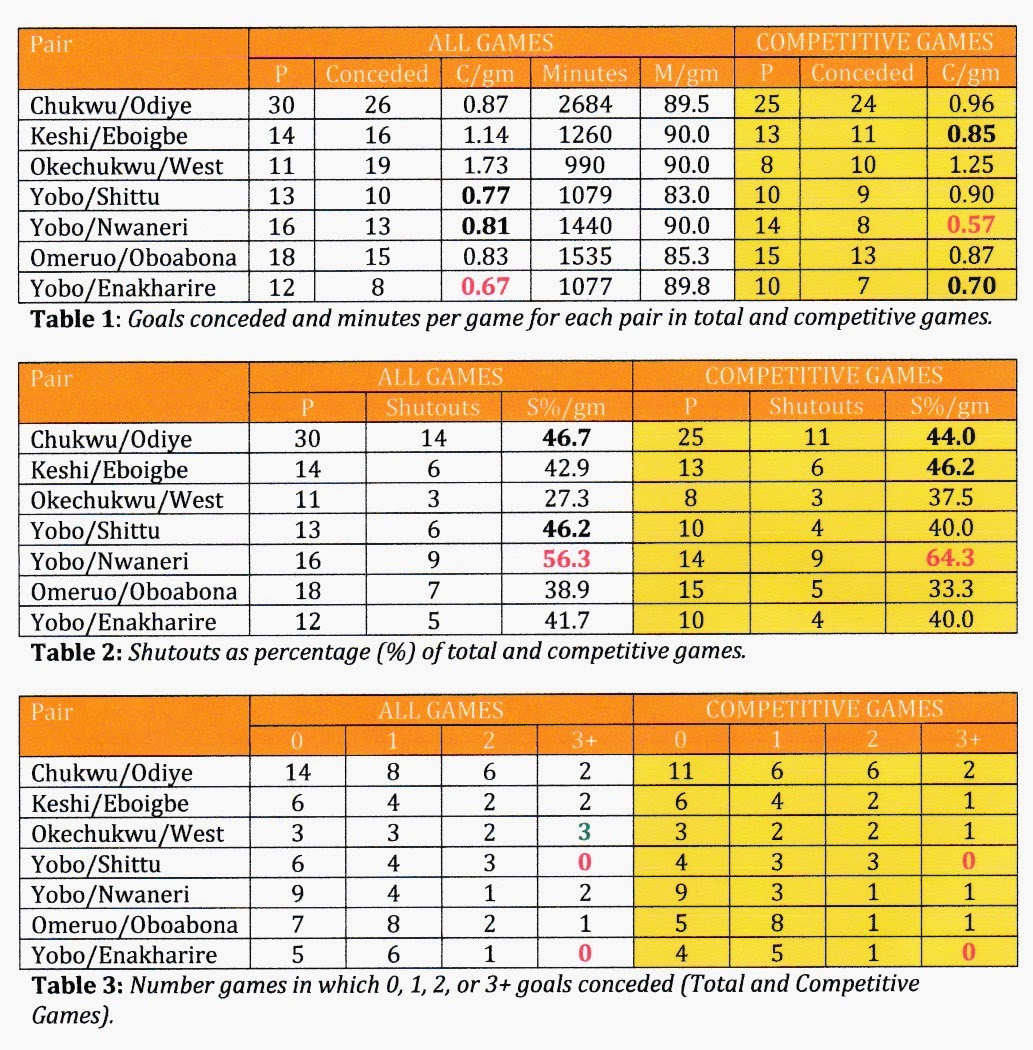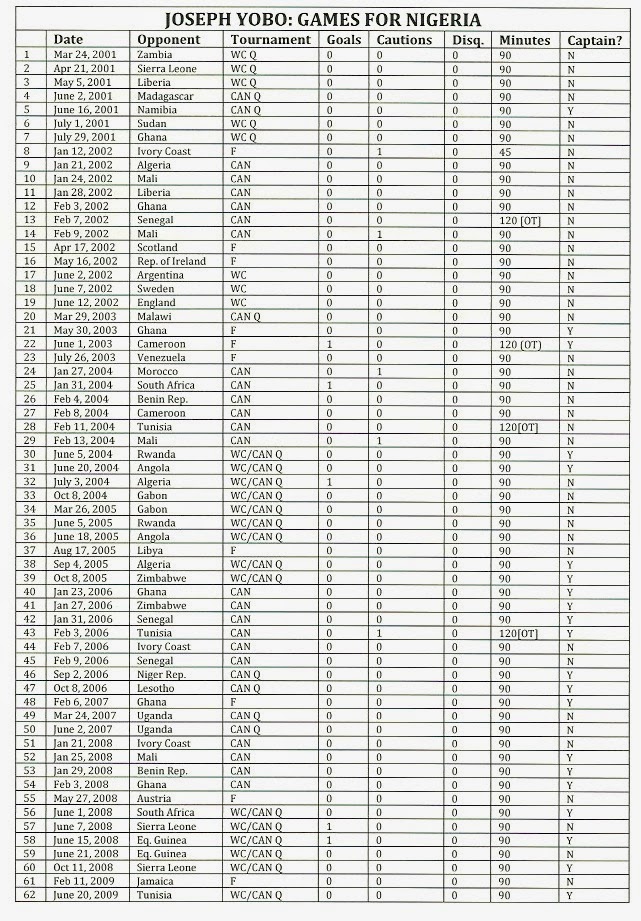Comparing Player Pairings in Heart Of Eagles Defense
Nigeria has historically built its defense on pairings in the center of its defense. The two players in the center often have exclusive defensive roles whereas wide defenders are allowed to attack with the rest of the team when necessary. We are interested in comparing several historic pairing of players in those central defensive positions since the mid-1970s. We have chosen the mid-1970s because this was the period when Nigeria became unquestionably among Africa's top teams. Prior to that Nigeria, the country's national team had done very little to be considered among Africa's best. Thus, we believe, at least theoretically, that the pairings played for similarly strong Nigerian teams. While they were not solely responsible for defensive results obtained by the team, it is clear that they had significant roles in achieving those results.
We looked at seven such pairings that meet the criteria of at least 10 games started together. The seven selected were Christian Chukwu/Godwin Odiye, Stephen Keshi/Sunday Eboigbe, Uche Okechukwu/Taribo West, Joseph Yobo/Daniel Shittu, Joseph Yobo/Obinna Nwaneri, Yobo/Enakharire, and Kenneth Omeruo/Godfrey Oboabona. We left off pairings such as Keshi/Okechukwu and Chukwu/Bamidele because those failed to meet the criterion of at least 10 games. Importantly, games played by selected pairs were left out if one of the players failed to play at least 50% of the said game e.g. Omeruo/Oboabona v Spain at the Confederation Cup of 2013.
We then compared these pairings on various measurements including the following: Goals conceded per game, minutes played per game, shutouts per game, number of goals conceded per game categorized on 0-3 or more goals. Then several of these measures were also compared on whether the game was competitive or non-competitive.
The Results
The results are surprising. The pairing of Yobo/Nwaneri, which is widely believed to be one of Nigeria's historically poor center back pairing, provided the best statistical results not just in goals conceded per game (Table 1) but also in percentage of total games with shutouts (Table 2), in all games or in competitive games. Also notable is the low number of goals conceded per game achieved by the pair of Yobo/Enakharire (Table 1). Many may attribute these results to the coach in most of their games i.e. Shuaibu Amodu who is widely reputed as a defensive coach. Nwaneri, as most remember, was not adept at bringing the ball upfield with a pass and he as well as Shittu were focused on clearing the ball to safety. However, the fact remains that pairing of Yobo/Nwaneri was successful in achieving the defensive results. But much more telling with the general results is that Nigeria was statistically conceding a goal per game no matter the pairing considered.
On the other hand, the much hyped Keshi/Eboigbe and Chukwu/Odiye pairings produced poor or middling statistical results, at best, when tested on goals conceded per game. However, they ranked better in shutout percentage during competitive games (Table 2). The least appealing pairing was the Okechukwu/West pairing that conceded almost two goals in each outing (Total games)! They also had three games where they conceded three or more goals (Table 3). Notably, the pair suffered major losses in the build up to the 1998 World Cup and the World Cup itself. This may well have skewed their results somewhat.
The graph shows at what point goals were conceded in games. This is based on percentages of total goals conceded across six timelines, three in the opening and three in the second half (Graph). A look at the data shows that most of the pairings conceded more goals after halftime except the Keshi/Eboigbe pairing which conceded more in the opening half. The Yobo/Shittu pairing did not show any particular inclination in terms of conceding goals.
We looked at seven such pairings that meet the criteria of at least 10 games started together. The seven selected were Christian Chukwu/Godwin Odiye, Stephen Keshi/Sunday Eboigbe, Uche Okechukwu/Taribo West, Joseph Yobo/Daniel Shittu, Joseph Yobo/Obinna Nwaneri, Yobo/Enakharire, and Kenneth Omeruo/Godfrey Oboabona. We left off pairings such as Keshi/Okechukwu and Chukwu/Bamidele because those failed to meet the criterion of at least 10 games. Importantly, games played by selected pairs were left out if one of the players failed to play at least 50% of the said game e.g. Omeruo/Oboabona v Spain at the Confederation Cup of 2013.
We then compared these pairings on various measurements including the following: Goals conceded per game, minutes played per game, shutouts per game, number of goals conceded per game categorized on 0-3 or more goals. Then several of these measures were also compared on whether the game was competitive or non-competitive.
The Results
The results are surprising. The pairing of Yobo/Nwaneri, which is widely believed to be one of Nigeria's historically poor center back pairing, provided the best statistical results not just in goals conceded per game (Table 1) but also in percentage of total games with shutouts (Table 2), in all games or in competitive games. Also notable is the low number of goals conceded per game achieved by the pair of Yobo/Enakharire (Table 1). Many may attribute these results to the coach in most of their games i.e. Shuaibu Amodu who is widely reputed as a defensive coach. Nwaneri, as most remember, was not adept at bringing the ball upfield with a pass and he as well as Shittu were focused on clearing the ball to safety. However, the fact remains that pairing of Yobo/Nwaneri was successful in achieving the defensive results. But much more telling with the general results is that Nigeria was statistically conceding a goal per game no matter the pairing considered.
On the other hand, the much hyped Keshi/Eboigbe and Chukwu/Odiye pairings produced poor or middling statistical results, at best, when tested on goals conceded per game. However, they ranked better in shutout percentage during competitive games (Table 2). The least appealing pairing was the Okechukwu/West pairing that conceded almost two goals in each outing (Total games)! They also had three games where they conceded three or more goals (Table 3). Notably, the pair suffered major losses in the build up to the 1998 World Cup and the World Cup itself. This may well have skewed their results somewhat.
The graph shows at what point goals were conceded in games. This is based on percentages of total goals conceded across six timelines, three in the opening and three in the second half (Graph). A look at the data shows that most of the pairings conceded more goals after halftime except the Keshi/Eboigbe pairing which conceded more in the opening half. The Yobo/Shittu pairing did not show any particular inclination in terms of conceding goals.



Comments
Post a Comment